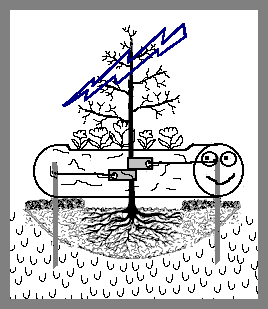Much has been written about the Northern Spotted owl as an endangered species. But almost no one understands that the species is important to an even less known or understood process which keeps forests of the Pacific Northwest in good health.
This process involves animals, almost all native plants, fungi -- and man.
Mycorrhizal fungi are essential to almost all plant life on earth. They gather water and essential elements, detoxify soils, and assist in protecting their host plants from pathogenic fungi. In the Pacific Northwest and elsewhere, these tiny thread-like organisms spread out from plant roots to form intricate mycorrhizal networks. A single square centimeter of soil may contain a mile of mycorrhizal mycelium. A square inch can hold several miles of mycelium. Unless the mycelium is densely packed together, it is not visible to the naked human eye.
Estimates vary concerning the dependence of plants on mycorrhizal fungi (MF). Most of these can only be guesses, because of the estimated 1,000,000 fungi suspected on the world today, only about 60,000 have been identified in science. Nonetheless, it can be stated with some surety that without MF, terrestrial plant life would cease. Without terrestrial plant life, terrestrial animal life would cease. As one of those animal species affected, it behooves us to learn much more about this relationship.
Many forms of mushrooms are presumed dispersed by wind. The spores drop from mushroom gills onto air currents. This can be verified by the presence of spores at 50,000 feet in the atmosphere.
Many of the essential MF in the Pacific Northwest are underground (hypogeous) fruiting truffles. These truffles can be either ascomycetes, basidiomycetes or zygomycetes. Literally hundreds of species have been described. For instance, "How to Know the Non-Gilled Mushrooms, Second Edition", by Alexander H. Smith, Helen V. Smith and Nancy S. Weber (c. 1981 by Wm C. Brown Company Publishers, Dubuque, Iowa), lists 149 species of the genus Rhizopogon alone. Many species novum still await scientific description (North American Truffling Society, PO Box 296, Corvallis, OR).
Even for experts these species are difficult to recognize. Alexander H. Smith noted he had the largest collection of unidentified Rhizopogons, in addition to the largest collection of identified Rhizopogons in the world.
Because these fungi fruit underground, they rely upon animals to dig them and eat them. Without being eaten, truffle spores cannot be dispersed.
Only very recently have any species of Rhizopogons been cultivated. Almost no MF have been reliably cultivated. Yet in nature, they are common with healthy trees.
Compounding the problem of cultivating MF is that as trees mature, the MF associated with them change. MF found with young trees, for instance, are often species of Martellia, Hymenogaster, Hysterangium, Endogone, Barssia, and Rhizopogon. But after full canopy is reached (usually about 5-15 years from seedlings), other MF suddenly become common, including Tubers, Radiigera, Melanogaster, Leucogaster, Balsamia, and Alpovas. Finally, the MF needed for old-growth forests vary greatly with slope, rainfall, elevation, and tree species. Most tree nurseries are located at low elevations, then planted at higher elevations. If these nursery-grown trees do not develop new, high-elevation MF quickly, they often die. This death has previously been attributed to "transplantation shock."
In the Pacific Northwest of the United States, the most common dispersal agents for truffles are small rodents called voles. Chris Maser in The Redefined Forest notes voles are the most common animals west of the Cascade Mountains, with potentially over 500 animals per acre of forest. Almost no one has actually seen voles, and in the 1970's, the California Red-backed voles was listed on the Endangered Species Act. By careful research, Chris Maser has shown that not only are these animals not endangered, but are an essential part of the forest health through their dispersal of truffle spores. Maser notes that each vole produces about 300 fecal pellets daily, each of which contains over 100,000 spores. Each spore is capable of inoculating a new tree with several species of MF.
Another important dispersal animal for truffles in the Northern Flying squirrel. Studies have shown that during six months of the year, the flying squirrel eats almost nothing but truffles.
As MF spores can pass through a mammal's digestive system without harm, it also appears that the spores pass through birds digestive systems with equal ease. The major predator of both Northern Flying Squirrels and California Red-backed voles are Northern Spotted owls. Unlike other owl species, these owls have short-stubby wings, appropriate for flying through dense forests with multiple forest canopy levels, which most other owl species cannot do.
Finally, the Northern Spotted owl is also a prolific hunter. Each
day it flies up to 40 miles in its quest for food. And each time it defecates
or regurgitates a pellet, it effectively inoculates a new area MF species.
By constantly sampling prey in many areas, it effectively disperses hundreds
of MF species. Almost none of these species has been cultivated to date.
 Dictionary MAIN PAGE
Dictionary MAIN PAGE